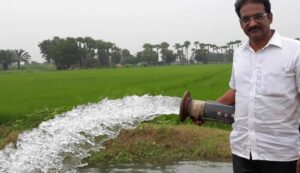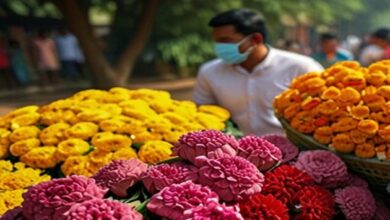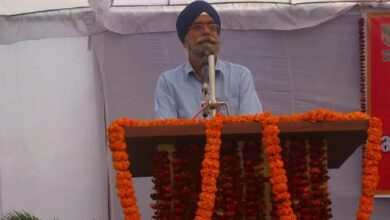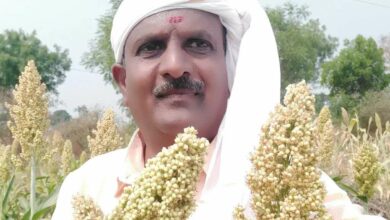This farmer revived the 124-year-old ancestral farming system and is earning lakhs of rupees today
Success Story: Not just any farmer, Satish Babu Gadde is from Seethampeta Village in the West Godavari District of Andhra Pradesh. He is the 124th generation to continue his grandfather’s agricultural legacy, which dates back to 1900. A postgraduate in business, Satish is one of his family’s four generations to engage in “regenerative cattle-based agriculture.” By stressing the symbiotic interaction between cattle and soil, this agricultural approach ensures farming that is both productive and sustainable.

Soil And Cattle Complement Each Other
According to Satish, cattle are necessary for agriculture. He said, “Soil and cattle are complementary to one another. The fertility of the soil is restored by the excrement and urine of cattle, and the cattle are fed by the fodder crops that are planted in the soil.” For Satish, this has been his family’s agricultural approach for more than a century; it’s more than simply a conviction.
Satish has cleverly separated the three sections of his 52-acre farm—one for rice, one for maize, and one for coconut palms. Despite sticking to a single crop pattern, he has doubled his profits by combining conventional agricultural practices with cutting-edge knowledge. He accomplishes it as follows:
Satish Cultivates Paddy: From June to November, Satish cultivates paddy. He switches from harvesting rice to maize, using the leftovers to feed his cattle until the next planting season. His careful techniques guarantee that he obtains 62 kg of rice from every 75 kg of paddy, which is far greater than other farmers’ average yield of 45 kg. His extraordinary productivity is proof positive of the value of his customary methods.
Farming Coconuts: Satish has set aside 16 acres for the exclusive purpose of growing coconuts. He takes a different strategy; he attaches his cattle to the coconut trees so that their urine and excrement organically nourish the soil around the roots of the palms. By using this strategy, trees may now produce an amazing 240–270 coconuts a year, far more than the 170 nuts that the Coconut Board of India claimed. Because there is no intercropping, production is further increased, and merchants are ready to pay two rupees more per coconut because they recognize that his products is of a higher quality.
Creative Farming Methods: Advantages Not Found in the Ordinary
In addition to cultivating crops, Satish’s farming practices tackle some of the most important issues facing modern agriculture.
Disease Prevention: Satish successfully stops the development of illnesses like mastitis, a significant problem in Indian cattle ranching, by letting his cattle roam freely over the fields instead of housing them in sheds. “In India, we lose about 27% of cattle every year to diseases,” he states. “But by using this technique, we’ve managed to reduce that number significantly.”
Natural Weed Control: Cattle are a natural weedicide since their urine is evenly spread over the fields due to their constant movement. This keeps weeds under control and reduces the need for toxic chemical pesticides, which makes his farm more environmentally friendly.
Water conservation: Satish’s crop arrangement uses the least amount of water possible, which is advantageous in areas where water is a limited supply. Water is subsidized by the government, but Satish’s techniques make sure his farm makes good use of it. His animals also contribute as they graze by aerating the soil organically, which enhances moisture retention via evaporation.
Cattle Are Necessary To Maintain The Purity Of The Land
Satish’s agricultural philosophy is in complete harmony with the tenets of Swachh Bharat, the national cleanliness initiative of India. He thinks that cattle are essential to preserving the purity of the air, water, and land. “Out of the five elements essential for life, cattle help control three: soil, water, and air,” he says. His agricultural methods support a more ecologically friendly and sustainable ecology by maintaining these components in good condition.
A Prosperity And Sustainability Cycle
Satish’s methods for raising cattle are also a reflection of his dedication to sustainability. He makes sure calves are nurtured in the natural way by their moms, which strengthens their immunity and promotes adult health. His farm receives around eleven or twelve baby calves every year. The revenue generated from his crops and the sale of aged cattle gives him a reliable and sizable income that allows him to continue and grow his farming activities.
According to Satish, his earnings are five times more than those of the average farmer in the area. Selling rice for Rs. 100 per kg brings in a gross revenue of Rs. 97,200 per acre for him. He also receives an additional Rs. 340–350 per coconut tree, for a total income of around Rs. 17,000–17,000. In addition, he makes around Rs. 4 lakhs in gross revenue from the sale of cattle, which fetch Rs. 80,000 apiece. His yearly income surpasses Rs. 60 lakhs in total.
Exchanging Information And Broadening Views
Others might take inspiration from Satish’s achievements. He intends to apply his methods to other sectors, emphasizing the enhancement of soil fertility and raising agricultural yields by the tactical use of cattle. His ultimate objective is to impart his skills to other farmers in order to support the revitalization and preservation of India’s rich agricultural legacy.
In a world where contemporary agricultural techniques often result in unsustainable practices and environmental devastation, Mr. Satish Babu Gadde’s narrative shines as a ray of light. His success in conventional, cattle-based farming gives farmers worldwide hope for a successful and sustainable future. The tale of Satish serves as a potent reminder of the timeless worth of customs that have been handed down through the ages—customs that are not only pertinent in the present but also necessary for a sustainable future.





